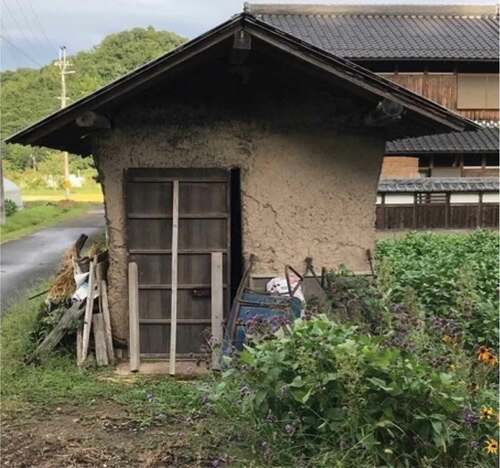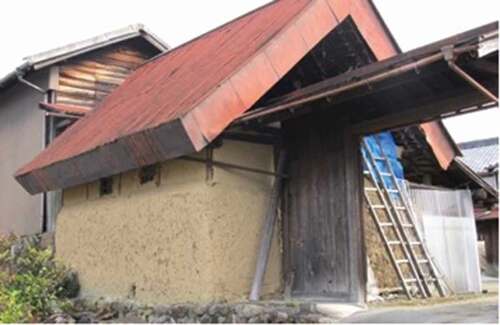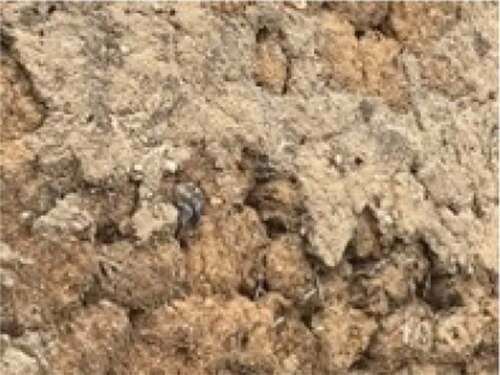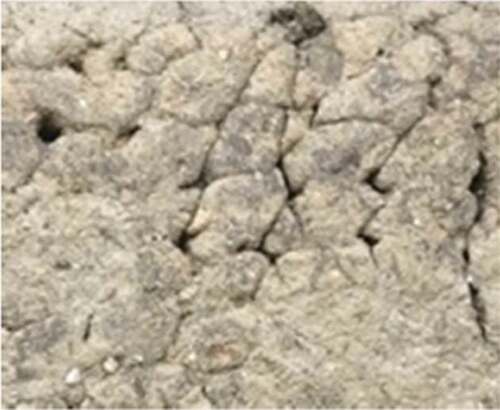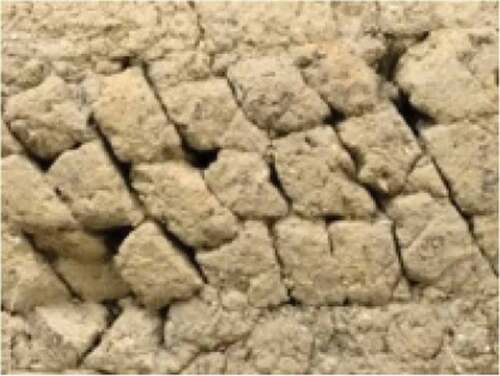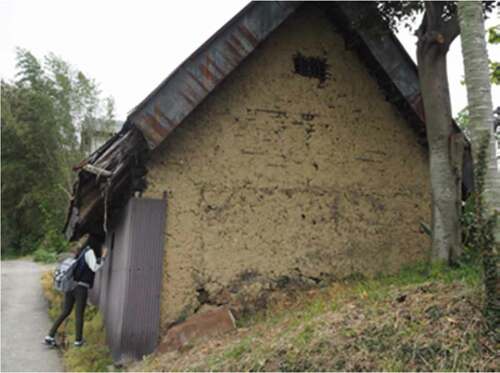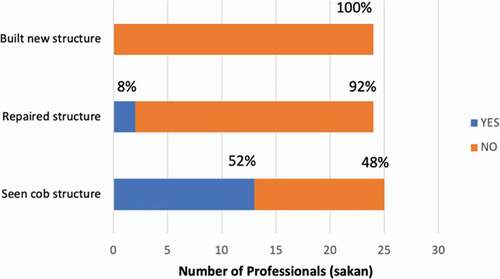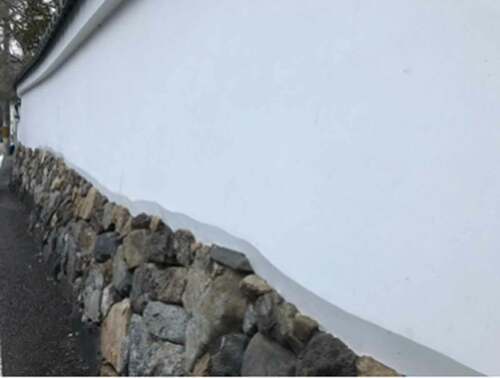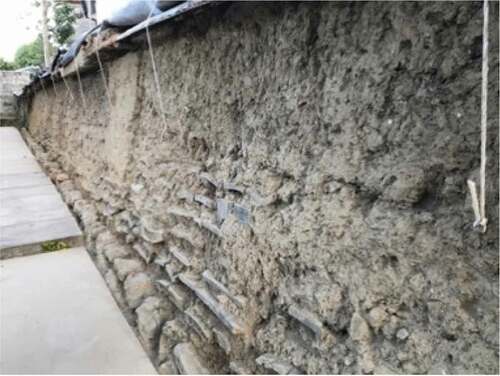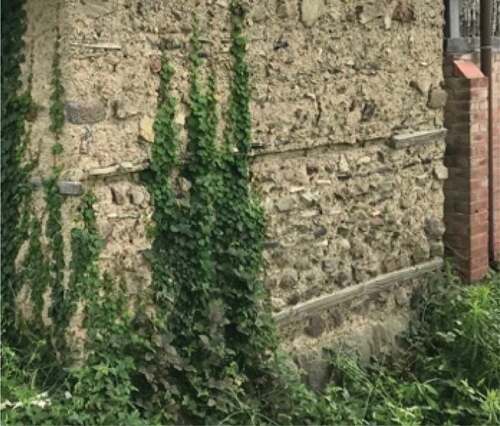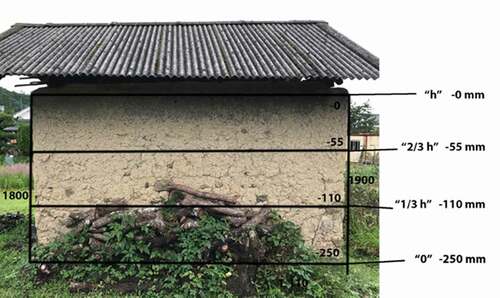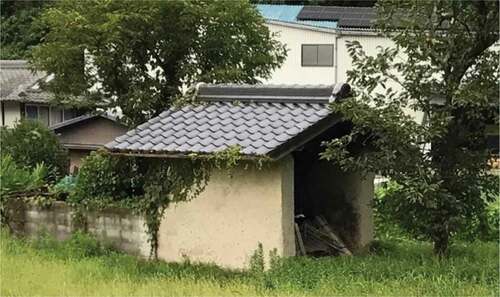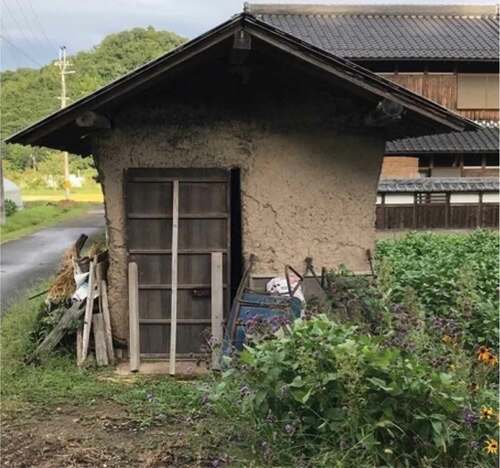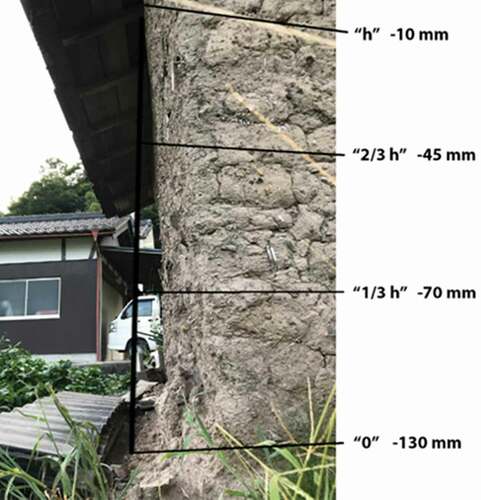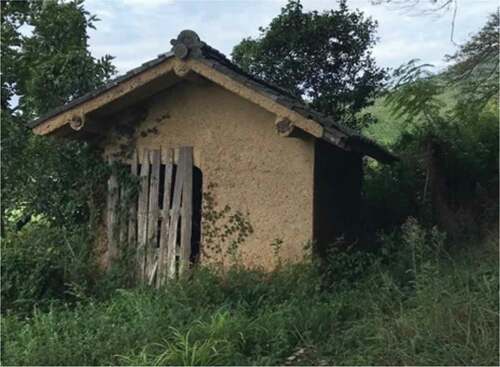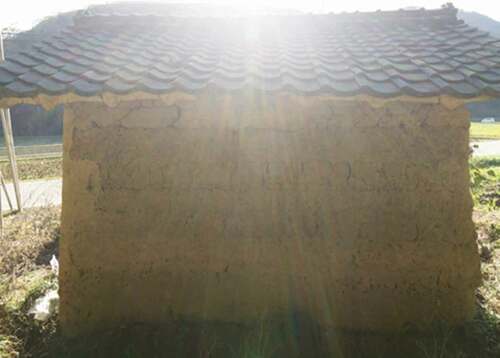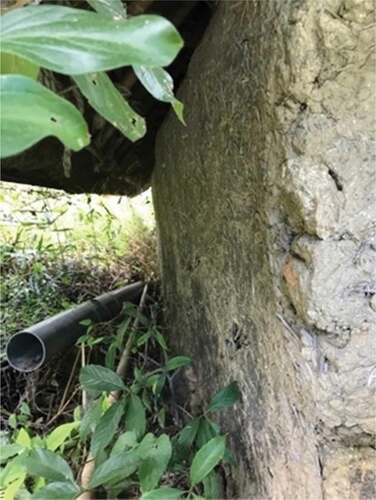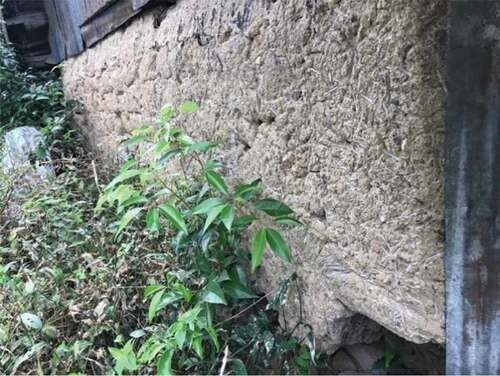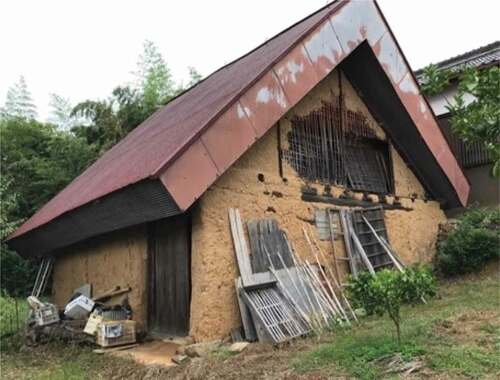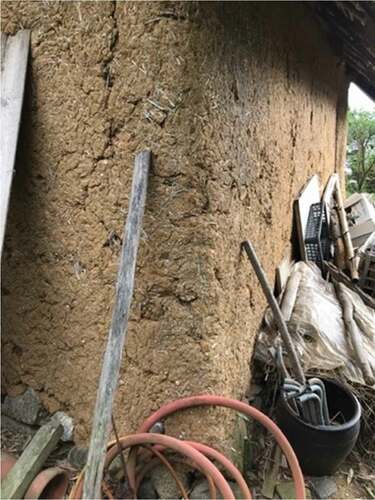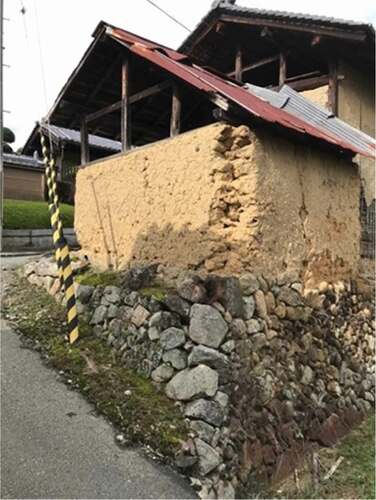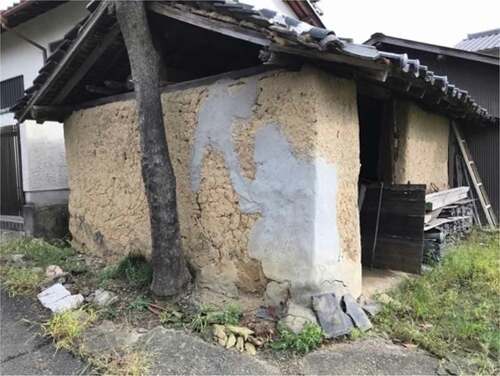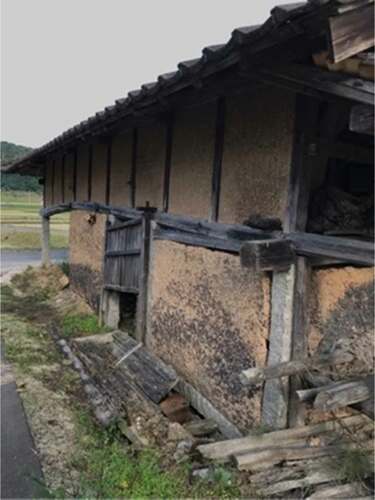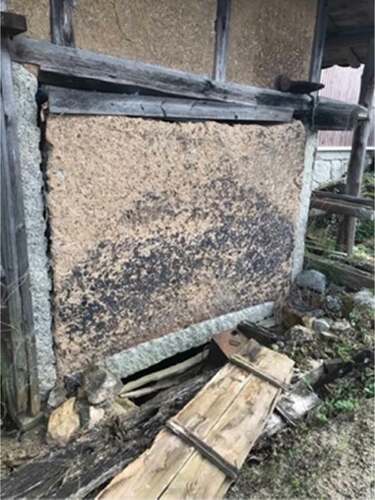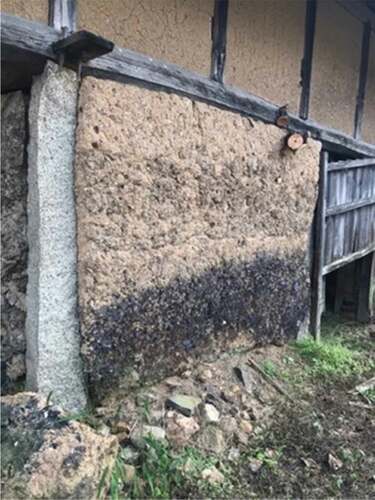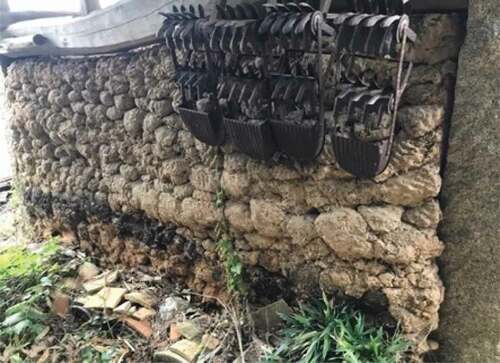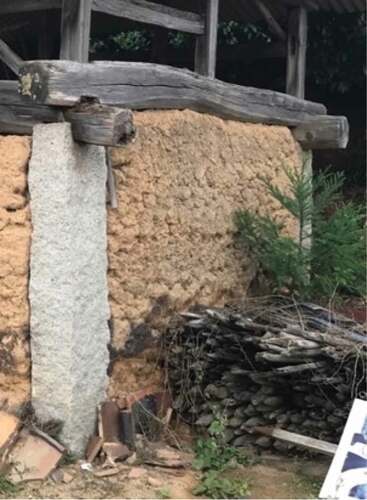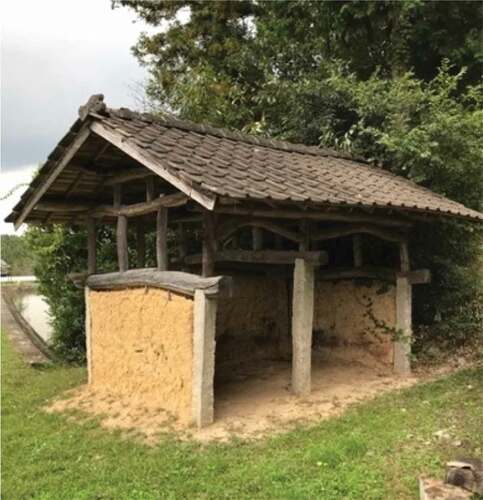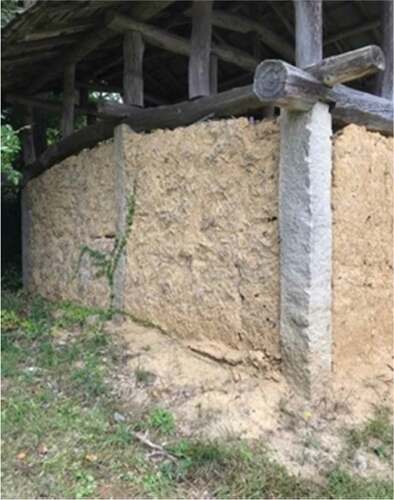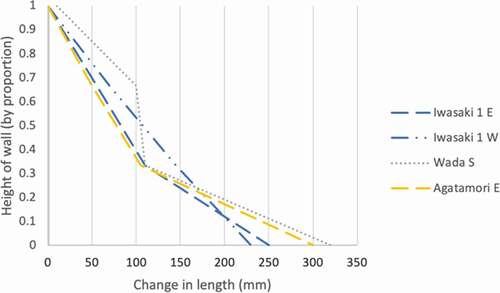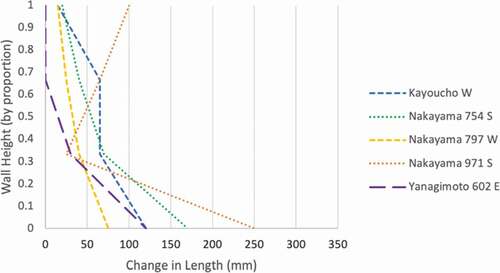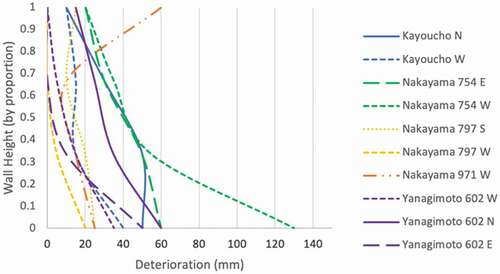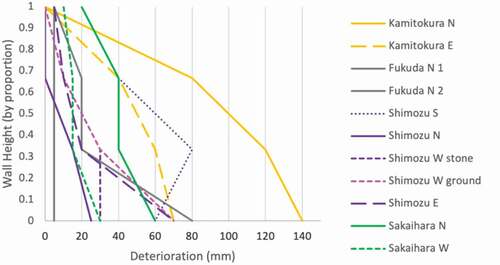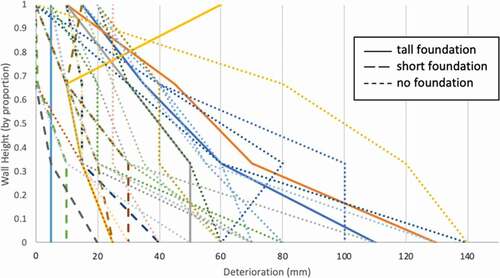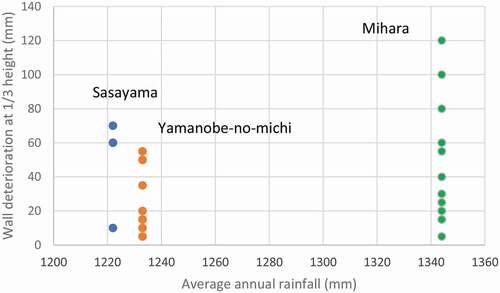ABSTRACT
The benefits of using earthen material such as cob in architecture are increasingly acknowledged, yet remaining concerns about safety prevent its broader use. This is particularly true in areas that experience earthquakes and heavy rain. To better understand the structural characteristics of cob in such harsh environmental conditions, this study examines cob structures found in rural areas of Japan, which are subject to those conditions. On average, we found they have been standing for 80 years. First, through interviews and surveys, this study verifies that amateurs built these structures; that is, they were built under worst-case scenarios for quality control. Second and mainly, field work measurements provide data to show deterioration patterns over decades, and sometimes centuries. Major findings were as follows. As expected, the bottom of the walls is most susceptible to deterioration. Unexpectedly, the data appears to show that deterioration is minimized when foundations are short, using small stones, 80 mm to 140 mm in height. The average deterioration at the bottom for walls with tall foundations (150 mm in height and over) is 64 mm, and for walls with a short foundation is 25 mm.
1. Introduction
The purpose of this study is to determine the circumstances contributing to the deterioration of cob structures in rural areas of Japan. Measuring and recording the deterioration of these long-standing structures adds to our knowledge about the longevity and safety of cob structures. Obtaining this data may help expand building with cob around the world, particularly in regions susceptible to frequent earthquakes and/or high volumes of rain.
Universally, cob is made of earth (clay/sand/silt), aggregate, and – often – straw. Japan has its own unique ways of working with cob, the use of which appears split into two categories: perimeter walls built professionally, and agricultural structures, or sheds, built by local farmers. In this study, we begin with verifying who exactly built these cob structures. If indeed the cob structures are built by amateurs, then studying the deterioration circumstances of these structures provides insight into the worst-case-scenario structural characteristics of cob walls.
The survival and continued use of these old cob structures reflect the durability characteristics of earthen material in general, and cob specifically. Common concerns around the use of cob often revolve around its vulnerability to severe weather and earthquakes. A country known for frequent storms and occasional earthquakes, Japan’s environmental challenges significantly test the durability of cob. Therefore, collecting data in Japan offers further insight into the deterioration rate of cob and earthen walls in general. It is also significant to note that, while some of these structures show patch-work maintenance, the majority appear to be unmaintained.
In recent years there has been a great increase in the number of published papers on various types of earthen construction. Cob, however, remains the least studied, compared to rammed earth and adobe. Studies on the performance of cob include that of Forster et al. (Citation2008) who presented case studies on flooding experiments for cob in England. Tests of the compressive and shear strength of cob have also been conducted, including those of Quagliarini et al. (Citation2010). Other publications look at cob’s potential in a modern context (Hamard et al. Citation2016; Eid Citation2018). However, it is difficult to locate studies closely examining the deterioration of existing old buildings made from cob. While there is no research on cob weathering, Bui et al. (Citation2009) examined the durability of rammed earth walls over the course of 20 years. They concluded that the rammed earth wall could weather for 60 years before it reached an “unacceptable” 5% erosion.
Japan has a long history of using natural materials such as wood, bamboo, and earth in its architecture. However, the existence of old structures made with cob is a relatively new academic discovery. These cob structures are unique in Japan because the weight of the roof is carried entirely by walls made only of earth, without the use of wooden posts (). In other words, these are load-bearing cob wall structures. Structures with stone pillars and cob infill between pillars can also be found.
Cob has been used to build residences around the world for a very long time. In most places, it is a wet mix of clay and aggregate with long lengths of straw, which is shaped into a monolithic wall by manually integrating the material with itself to form a single, load-bearing earthen mass. Differing from monolithic cob structures seen in other parts of the world, Japan’s cob construction stacks mud in individual shapes to build thick, load-bearing cob walls. These walls are not made of rammed earth or adobe (i.e., dry earth brick), are not wattle and daub or poured earth, and therefore belong within the “cob” category. Research by Nakamura et al. (Citation2019) found that there are three methods of building with cob in Japan: stacking mud balls, stacking mud piles, and stacking wet earth brick (). Cob material used in Japan may or may not include straw (Nakamura et al. Citation2018).
First, in this study we examine who built the unique cob structures of Japan. Unlike cob perimeter walls, they do not appear to be professionally built.
We know that, for centuries, Japan’s plastering professionals (sakan) have built perimeter privacy walls around properties using methods which sometimes include cob, as temples keep a careful record of construction and reparation services. This method of building perimeter walls is common knowledge among professionals in the industry today (Sato & Yagasaki, 2012, pp.126–130). These walls serve the function of enclosures, not structures. While today you can find many of these walls being maintained by sakan as shown in , there is no information linking sakan with the construction of roofed cob structures.
Figure 5. A 2017 sakan surface restoration of 100-year-old Kyoto temple perimeter wall reveals cob ball core.

Though, at first glance, constructed similarly to perimeter walls, Japan’s load-bearing cob structures such as seen in often lack the benefit of a brown coat of earthen plaster and almost always lack a finish coat of lime or earthen plaster, as is common in professional work.
The structures’ very existence remained largely unknown in Japan until recently, contributing to the anecdotal theory that they have never been part of the professional’s work. Confirming this theory will inform us about the quality of the work. This in turn can inform expectations regarding the longevity and performance integrity of structures built in this way.
The second and main aim of this study is to learn the circumstances contributing to the deterioration of cob walls. Because the structures appear to be built by amateurs, deterioration would presumably happen at a faster rate than that of professional work. And yet, these old structures still stand and remain in use. Therefore, collecting data about their deterioration can help us anticipate the longevity to expect from cob walls.
When building new cob structures today, a chief concern is for the structures’ safety performance in regions with heavy rains and earthquakes. It is important, then, to locate, collect data, and evaluate cob architecture in such regions. As Japan is well known for earthquakes and storms across the country, it offers good conditions for such case studies. Here we can study the deterioration of relatively primitive cob walls, existing under relatively harsh conditions for decades and sometimes centuries. As codes and regulations are developed for the architectural use of cob, such data may prove useful.
2. Method: interviews for understanding the origins of Japan’s cob
While cob perimeter walls are common throughout Japan, cob structures only exist in certain scattered, rural regions. Discovery and investigation are ongoing.
Some academic literature and studies inform us about these structures. There appeared to be a clear split between who builds cob perimeter walls (professionals called sakan) and who builds cob structures (amateur builder-farmers). Further inquiry into this matter was necessary for confirmation.
Sakan were consulted to learn about their experience with cob. First, interviews were conducted with selected sakan in specific regions. Then, a survey was distributed to sakan around the country to get a broader view of the professional use of cob.
Results of interviews and surveys, together with the author’s photo collection, were examined to find detailed differences between cob use by professionals, versus cob use by amateur builder-farmers.
2.1. Interviews and surveys with sakan
Academic literature and studies were searched for information about who built these cob structures, which were all found in the farmlands of four prefectures.
Professional earth plastering practitioners were consulted and surveyed to understand their experience with cob building. Also, sakan in the regions of Nara, Kyoto, and Hyogo prefectures were selected for interview.
Interviews: Local sakan have a uniquely regional perspective. All elder sakan began their training when using earth in construction was common in Japan. They often have insight into rural/agricultural lifestyles. Selected sakan were shown images of the cob structures and given details from site visits. They shared their opinions on likely construction methods. They were also asked about their experience using cob techniques in their own work.
Survey on the use of cob in professional work: To better understand the broad, nationwide experience of sakan using cob, 46 sakan on the social media platform Facebook were identified and sent a survey.
Questions were as follows:
Q1. Have you ever seen a cob structure? (Y/N. If yes, where?)
Q2. Have you ever repaired a cob structure? (Y/N. If yes, where?)
Q3. Have you ever repaired an earthen perimeter wall? (Y/N)
Q4. If yes to Q3, how many perimeter walls have you repaired?
Q5. If yes to Q3, do you know if the wall’s core was built with cob? (Y/N. If built with cob, where was this wall located?)
Q6. Have you ever used cob to build a new perimeter wall? (Y/N. If yes, where?)
Q7. Have you ever built a new cob structure? (Y/N. If yes, where?)
3. Method: deterioration research
Over time, weathering deteriorates earthen walls, changing their dimensions. Observation around the base of the walls allows identification of the original dimensions of the structure’s footprint. Then we can determine how much of the wall has deteriorated.
Cob structures in Japan always have a shed-shape, with four sides and four corners. The corners of the walls are most susceptible to damage, because of the increased exposure of surface area. At the corners, it is possible for deterioration from both sides to occur due to rain. This weakens the bond of the remaining cob at the corner, further quickening deterioration. Changes in the corners were measured because understanding their deterioration provides useful information about the longevity and safety of these structures.
Measurements were taken to determine how much of the surface has deteriorated through the lifetime of the wall. This tells us how the thickness of the wall has changed. Having found the original footprint through careful observation, a line was made from the undeteriorated top of the wall, to the location of the original footprint, at a point that seemed to best represent average deterioration across the entire face of the wall (and at the corners). This line represents the “original shape” of the wall. Measurements were taken at the bottom, 1/3 height, 2/3 height, and top to measure corner deterioration, and learn surface deterioration. As with cob structures in other countries, most walls appear to be originally constructed to taper from bottom to top, with the cob wall widest at the base.
3.1. Site visits
Site visits were conducted in three prefectures: Hyogo, Nara, and Hiroshima. [A fourth prefecture, Yamaguchi, was also visited to examine the largest cob structures found existing in Japan. By dimension, these look identical to the typical two-story store houses found all across the country, called “kura.” However, these great examples of large cob structures, standing for over a century in Japan, could not be measured in the same way as the smaller shed-type structures of other regions. They are too tall, between 4000 to 5000 mm. They are simply mentioned here because they are important examples when fully considering cob structures in Japan.]
3.1.1. Sasayama region of Hyogo prefecture
Cob structures in this region are fully cob from ground to roof, without any other type of framed construction. Locations identified by Hatanaka et al. (Citation2020) were examined. Though decreasing in number due to lifestyle changes, cob “ash houses” (haiya/hanya) are scattered throughout the valleys of this region. They were used to burn agricultural waste products to make ashes to return to the field as fertilizer. The ceilings and outside eaves were plastered with earth to prevent the structure from burning during these operations. Today, some of these structures remain in use as storage sheds, while others, mostly located at the base of hillsides, have been left to decompose and return to the earth.
The following details were recorded for structures still in use:
Directionality (North, South, East, West) of the walls.
Relationship of each side of the structure to its surrounding landscape; for example, the presence or absence of other structures or trees adjacent to the cob structure. This helps to explain the factors contributing to or deterring deterioration.
Presence/absence of earthen plaster layer over the cob; presence/absence of straw in plaster layer; presence/absence of straw in cob (where visible).
Presence/absence of a foundation, and its surrounding conditions. Height measurements of foundations were recorded, and observations made about how water accumulates and flows around the footprint of the structure, affecting the deterioration of the lowest part of the wall.
Depth of eaves.
Change in wall length and thickness. Measurements were taken related to the change in wall length and wall thickness due to deterioration of the outer surface. These data were used to produce graphs expressing these changes. First, the original footprint of the bottom of the wall was identified. Then a straight line was made from the unchanged top of the wall to the original location of the footprint to measure:
Change in length. For walls with both corners accessible for measurement, the original location of the edge of the wall was determined by making a line from the undamaged top cornerto the original location of the bottom corner of the wall. The changes in dimensions of the two corners were added together to obtain the total change in wall length. Measurements were taken at ground level, 1/3 height, 2/3 height, and at the top of the wall.
Change in thickness. Surfaces were examined to locate the point of average deterioration. This point was measured in the same way the corners were; by making a line from the top of the wall to the original footprint at the bottom, and then measuring the deterioration at the ground level, 1/3 height, 2/3 height, and at the top of the wall.
3.1.2. Yamanobe-no-michi of Nara prefecture
Structures located here are nearly evenly split between half-cob structures (bottom half cob, top half framed with wood and bamboo), and fully cob structures. Locations were identified following the research of Nakamura et al. (Citation2019), and a book about the region’s unique cob structures (Kobayashi, Okui, and Fujita Citation2005). These cob structures were originally built primarily for storing fruit harvests (citrus and persimmons), and now continue to be used for the storage of supplies and equipment. The same details were recorded as in Sasayama.
3.1.3. Mihara in Hiroshima prefecture
Most structures found in this region could be defined as half-cob. The lower half uses stone pillars for corners. Long branches, three to five centimeters thick, were intermittently used as a framework, but not necessarily enough to be structural, as can be vaguely. The bulk of the walls are made with cob. These structures are currently being studied by a group of professors and students from several universities. Because the corners of the cob walls are made using stone pillars, there is no change in length to record. Data were collected to determine the change in wall thickness due to outer-surface deterioration.
3.2. Researching history of typhoons and earthquakes
Since Japan is regularly subjected to earthquakes and typhoons, records were searched to understand the environmental climate in which these cob structures exist. These results will be covered in the discussion section.
3.3. Comparing to USA’s new Cob Code
Although there is a surging interest in building with cob today, there is still little recorded data about how cob performs over time. Even so, with demand for environmentally sustainable, low-cost housing on the rise, the United States recently adopted the 2021 International Residential Code (IRC) Appendix AU, hereon referred to as Cob Code (International Code Council Citation2020). Results from our data collection were used as a lens to view this new Cob Code. This will be covered in the discussion section.
4. Results from search for origin of structures
Through investigation, it was confirmed that farmers themselves – amateur builders – built the unique, simple cob structures found in farmlands in some areas of Japan. They likely mimicked the work they saw done by sakan. Our interviews and surveys found that present-day sakan have never built cob structures like those found in Japan’s farmlands, and few have ever seen them.
4.1. Cob use by amateurs – local stories
The cob structures found in all locations studied are so old that it was rare to meet local individuals who know how the structures came to be. Occasionally, an elder was located who could share some information. These stories always revealed that the mud-portion of the work was done by the family themselves or the community together. This was confirmed through researching academic literature and through interviews.
Residents of Yamanobe-no-Michi in Nara prefecture shared their stories in a publication featuring photos and short essays by Kobayashi, Okui, and Fujita (Citation2005). A 74-year-old man described the neighborhood culture when he was a child. Many earthen storage sheds were built for mikan (citrus) storage after World War II ended. The 74-year-old man explained that, when he was younger, it was normal for children to help build these cob sheds. Hiring sakan to do the work would cost too much money so only the carpentry and roofing were hired out. Families knew where the best earthen material for building could be found in the neighborhood, he said. Another 75-year-old man described farming conditions when his family’s 200-year-old Edo-period shed was built (). An 83-year-old man told about receiving funding from the prefecture to build a mikan storage shed for their labor union in 1965, where members took turns raising the cob walls. The labor took 14 days, he said. A 72-year-old man said he doesn’t know who built the cob shed on the property bought by his grandfather, or what they built it for, but he is certain it is over 100 years old. The Ise Storm of 1959 blew off the roof tiles, causing damage to the structure. He still uses it to house farm machinery. Another cob storage shed existed on his property but was torn down in 1934 to build a new main house. That shed was used to make compost from animal excrement.
Cob “hanya” sheds used to be ubiquitous in the rural area of Sasayama, Hyogo prefecture. Today you can see remnants of many, with a number of them still standing and in use. In the past, each household had one (Nihon no Genten Shiriizu 7: Tsuchi [Japan Origin Series 7: Earth] Citation2014, 56). One resident with a cob “hanya” next to the house on her property is in her 80’s (personal interview, 10 September 2020). She remembers 70 years ago, working as a little girl to help her family re-plaster this cob shed. It was built by her grandfather to burn farm waste for ashes to return to the field as fertilizer. It has been minimally maintained but is still used for equipment storage.
Mihara, in Hiroshima prefecture, also has cob “hanya” scattered around the region. While these were also mostly used to burn or compost farm waste, their construction differs from those of Sasayama. They use square stone pillars for the corners of the structures, filling in the walls between the pillars with cob. One owner recalled helping to build the earthen wall portions of their family hanya when he was in middle school, 60 years ago. The shed was used to drain moisture from cow excrement so that it was lighter and easier to carry further away to the field for compost. It was affected by the large Geiyo Earthquake of 2001 and has never been maintained, but he continues to use it for new purposes as needed, such as storage (personal interview, 3 October 2020).
Through the interviews and research conducted in each region, two major common points can be seen. One, local experiential knowledge gave the amateur builders confidence that they could source material that was adequate to use for cob. Two, between 60 and 80 years ago, it was common for children to participate in the construction or maintenance of the cob structures.
4.2. Cob use by sakan
Professionals shared their experience through the survey and interviews, confirming that they do use cob with perimeter walls and that they are not familiar with cob structures.
4.2.1. Sakan survey results
The survey to 46 sakan returned 25 responses. Some who responded left some answers blank.
Graph 1 shows responses to questions about cob perimeter walls. Of the 25 respondents, 18 had repaired old perimeter earthen walls. Twelve respondents reported that the earthen perimeter walls they repaired had cob cores, much like you see in . These walls were in Nara, Mie, Fukuoka, Shiga, Ishikawa, and Kyoto prefectures. Seven respondents had built new perimeter walls. These were built using rammed earth (Anrakuji Temple in Kyoto City, and an unidentified structure in Kanazawa City, Ishikawa prefecture), dried adobe bricks (Sennyuji Temple in Kyoto City), and in one case, wet adobe bricks, or cob (Houryuji Temple in Nara prefecture).
Repairs for earthen walls remove only those layers necessary to accomplish the task. In other words, not all repairs require the removal of layers down to the core of the wall. Therefore, it is not always possible for professionals to know exactly how many earthen perimeter walls they have repaired are made with cob cores.
Many old perimeter walls are in various stages of deterioration. Sometimes the cob can be seen under the deteriorated surface. This situation was found in each of the three prefectures researched in this study. Therefore, it may be that cob is used in perimeter walls more broadly throughout Japan.
Graph 2 contains responses from sakan to questions about cob structures. Only half of the 25 respondents had ever seen a cob structure. Six of those 25 sakan were in Sasayama (who were all shown the hanya by a local sakan), two were in Nara prefecture, and one each in Nagano and Kagawa prefectures. Others did not specify where they had seen cob structures.
We can see from the responses regarding professional experience with cob structures that none of the surveyed sakan has built with cob in the way we find in Japan’s farmlands. It is therefore unlikely that professionals took part in this type of work.
4.2.2. Interview results
Interviews were conducted with four sakan in Kyoto, one in Nara (who worked on Houryuji Temple) and one in Hyogo (who took other sakan to see the cob “hanya” in Sasayama).
Only the sakan in Hyogo had seen a cob structure first hand (A. Kusumi, personal communication, 12 April 2019). Each sakan interviewed assumed that local amateurs had copied professional techniques to build their structures. In the process of the interview, one sakan in Kyoto, K. Oishi, said that “farmers are semi-professional at everything” (personal communication, 20 March 2019). The sakan in Nara pointed out that in the past it was common to utilize materials close at hand (J. Miyaoku, personal interview, 2 March 2019). Earth is abundant and free, which is important for frugal farmers. It is also a material that farmers could see first-hand as long-lasting: “Mountains don’t wash away with the rain,” he reflected.
4.3. Observed differences between professional and amateur work with cob from site visits
Observing professional and amateur work closely, similarities and differences become clear, especially regarding the precision of construction methods and foundations. Both groups utilize three types of cob – piles, balls, and wet adobe brick. The clearest difference is the method of construction. With stacked cob, professional work displays uniformity in a way not seen in the amateur-built cob structures ( vs. ).
Figure 7. Horyuji perimeter wall replication: (a) shows the laying of freshly made wet adobe bricks. They are being stacked on top of methodically embedded roof tiles; (b) shows the brown coat layer plastered over the bricks after they had dried; (c) shows the finish coat of the professionally built cob perimeter wall. (Photos taken by Miyaoku, J.).
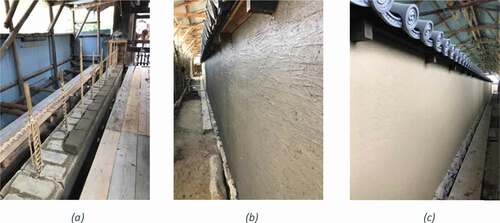
As seen in the survey results, it is rare for a sakan to have an opportunity to build a new perimeter wall. The Nara interviewee, however, had the opportunity to rebuild a section of an old cob perimeter wall, from the foundation up. This was at Houryuji Temple, which is a designated National Treasure. When repair work is done for a National Treasure in Japan, the methods used in the repair must be the same as those used in the original construction. Here, a section of the wall was entirely reconstructed (from the foundation) because it was in such a poor condition. Originally, this wall was built using wet adobe brick. And so, the wall’s reconstruction required using wet adobe brick. The sakan who led this project is the only one with detailed knowledge about how decisions were made regarding the process, but this individual is now too old to be interviewed. The Nara sakan who helped with the work documented the process with photographs (). The degree of precision employed – from the laying of the wet adobe bricks and through to the finish – is evident.
Professionally built cob perimeter walls are finished with a very flat surface using earth plaster or lime plaster (). Most amateur-built cob structures, on the other hand, have a simple layer of earth plaster covering the cob and lack the precise flatness seen at the professional level.
Professionally built cob perimeter walls always have a foundation that prevents the cob from wicking moisture up from the ground. Even on uneven stone foundations, the plaster covering the cob or other earthen core is shaped to fit the stones, further preventing water from puddling and damaging the wall (). Amateurs did not appear to use this technique, perhaps because it requires tools that they did not own.
Some professional perimeter walls use roof tiles, either included as a decorative element in the finish or embedded within the core of the wall. In , neatly laid tiles are seen acting as a filler within the cob core of a perimeter wall being repaired. Roughly 50 mm of the surface was removed to restore this wall, revealing the tiles. Tiles can be found embedded in many amateur-built cob structures as well, as seen in . In contrast to professional work, the inclusion of tiles in amateur work often looks random, with shards of tiles placed here and there throughout the wall. For amateur-built structures without a proper foundation, tiles and hard stones embedded at the base of the walls appear to accelerate erosion by providing a hard surface for water to bounce off, carving away at the surrounding cob material. This is particularly true at corners. (The results seen in section 5.2 were often a result of this pattern, where erosion at the bottom corner of the wall revealed large stones and tiles.)
5. Results of weathering measurements
During site visits, measurements were taken to assess the deterioration of cob structures as described above in METHODS, Section 3. Measuring the deterioration of these structures in three regions gave us some idea of the longevity of this type of building.
Weather-induced change in the wall length of cob structures throughout all three studied regions ranged from 70 to 320 mm. These structures range in age from 40 to over 200 years old. Deterioration of the walls’ surfaces ranges from 5 to 140 mm in structures between 10 to 200-plus years old.
Erosion of the walls was most severe at the bottom, especially where the cob touched the ground directly, or where stones and clay roof tiles had been embedded in the cob at the base of the wall.
Walls, with few exceptions, were originally plastered with a layer of earth 10–20 mm thick. The straw in this layer appears to be 20 to 50 mm in length. There are often pebbles of various sizes in the earthen plaster mix, ranging from 5 to 40 mm. Weathering first occurred through this layer and then often affected the cob underneath. On very few structures, there is a clear patch of “newer” plaster, indicating maintenance. This is often an earthen plaster with short straw left side corner), and, occasionally, a cement-based mortar.
The cob itself usually contains straw, cut between 50 to 120 mm. Some walls have large stones embedded within the cob, as well as roof tiles, as mentioned. The stones range from 80 to 250 mm in size. Surface deterioration of some structures reveal small-diameter bamboo or wood embedded across the length of the wall.
Many structures have one or two sides protected by other structures or by hillsides, slowing down erosion of the walls there, while others are completely exposed on all sides.
Most structures have no foundation, with cob touching the ground directly. Some can be found sitting on a short alignment of stones, usually around 100 mm high. Occasionally, a larger stone foundation protects the wall from contact with the ground.
The frame of the roof of each cob structure is carried by timber laid across the top of the cob. While some shorter structures have cob walls that go all the way up to the roofline, taller structures often have cob walls going only part-way up from the ground. In those cases, a wooden framework carries the roof, with a bamboo lattice to hold the earthen infill between the wooden posts and beams, as seen in traditional residences (Nakamura et al. Citation2019; Reynolds Citation2009). In almost every case, weathering towards the top of the walls is non-existent thanks to protection from the eaves, while the bottom of the walls is heavily weathered.
5.1. Site visit data collection
Three regions with known cob sheds were visited for data collection. Not all structures visited could be included in this study, and not every wall of each shed examined could be used to collect data. Some structures were not accessible due to overgrowth directly surrounding them. Some walls were directly next to another structure, preventing measurement. Some walls were not accessible because the personal belongings of property owners were stored against the walls, blocking access for measurement. (We could not locate owners for permission to move items.) Some walls had metal coverings to prevent further deterioration, preventing measurement. Therefore, the walls included in this study are limited to those which were easily accessible and measurable. In addition, not all walls measured were included in the data analysis for change in wall thickness because their measurement results were so similar, making the graph harder to read. However, all measured walls were included in the data analysis presented in Graph 8.
The following photos show all cob structures measured in this study. Each structure is pictured showing its surrounding environment and also showing the specific wall(s) measured.
In Graphs 3 through 7, each structure is grouped by color. N, S, E, and W (North, South, East, and West) in the legend denotes the direction to which the measured wall is exposed. North-facing walls are expressed with a solid line, South with a dotted line, East with a long dash line, and West with a square dot line.
5.1.1. Sasayama
Four structures in Sasayama had measurable walls. These are shown in .
5.1.2. Yamanobe-no-michi
Five structures in Yamanobe-no-michi were measurable. These are shown in and . has two walls which were measured and used in the data analysis, and is the structure “Kayoucho.” The wall to the left of the image faces north, and the wall to the right (with adjacent gate) faces west. in the introduction shows the structure and the immediate environment of Nakayama 754, shown also in . The wall seen in faces west.
5.1.3. Mihara
Four structures in Mihara had measurable walls. These are shown in .
Figure 30. Fukuda in Citation2013 (western-most wall intact) (Google, Citation2013).

5.2. Change in wall length
This sub-section organizes the results from measuring the change over time in the cob structures’ wall-length.
Structures in Sasayama and Yamanobe-no-Michi were measured for change in length of the wall. In almost every case, the change of wall length at the top of the wall was very slight or non-existent, and the greatest deterioration could be seen at the ground level.
The results of Graph 3 and 4 show that all walls have more severe weathering at the bottom. It is helpful to keep in mind that the weathering is happening at the corners of the structures. These are the most exposed and most vulnerable areas.
Graph 3 shows results from Sasayama, in Hyogo prefecture. Three structures had walls where the change in length could be measured. See for wall measured, age of the structure, foundation type, the height of the cob portion of the wall, and eave length.
Table 1. Sasayama walls measured for changes in length.
Of note, the structure in Wada () was built at least 100 years ago and was re-plastered 70 years ago on the outside by the current 80-year-old resident and her family (personal communication, 10 September 2020).
The structure in Agatamori sits directly on the ground (). The measurable wall here is in a location where water flows directly along the bottom of the wall every time it rains. A neighbor working in the adjacent rice field believed that it was built about 40 years ago (anonymous, personal communication, 11 September 2020).
Graph 4 shows results in Yamanobe-no-Michi, in Nara prefecture. Five structures had walls where the change in length could be measured. See for wall measured, age of the structure, foundation type, the height of the cob portion of the wall, and eave length.
Table 2. Yamanobe-no-michi walls measured for changes in length.
Of note, Kayoucho () is a structure within a residential compound, sitting on a hardened surface rather than bare ground.
Kayoucho, Nakayama 754 and Nakayama 797 have thatched roofs. The thickness of the thatch offers broader protection for the walls which are not on the gable end. On the other hand, those walls which are on the gable end of the structure have very little overhang protection, as the apex of the thatch is 4000 to 5000 mm above ground, leaving the wall almost completely exposed to the elements.
5.3. Change in wall thickness
This sub-section organizes the results from measuring the changes of the cob structures’ wall thickness over time.
We can obtain a good understanding of the rate of deterioration of these simple earthen cob walls by measuring the deterioration of the surface. With most structures, there is a clear point along the height of the wall where weathering begins to occur. This seems to coincide with the elevation to which the eaves of the structure protect the walls from rain.
Graphs 5–7, like Graphs 3 and 4, show that most of the time, the greatest deterioration happens at the base of the wall. The oldest known structure is 200 years old (Kayoucho of Yamanobe-no-Michi), and the newest known structure is 10 years old (Iwasaki 3, Sasayama). All other structures with known ages have been standing for an average of 80 years. With that, the most that any structure has worn in thickness at the bottom is 140 mm. This is the case for all three regions. Though difficult to measure precisely, most walls in Sasayama now measure 300 to 360 mm thick; most walls in Yamanobe-no-Michi now measure 300 to 380 mm in thickness (Nakamura et al. Citation2019); and most walls in Mihara now measure 200 to 270 mm in thickness, which is similar to the width of Mihara’s weight-bearing stone pillars.
Graph 5 shows results from Sasayama. Four structures had walls with measurable surface deterioration. See for wall measured, age of the structure, foundation type, cob wall height, and eave length.
Table 3. Sasayama measurements for surface deterioration.
Of note, the wall measured in Agatamori has no foundation and gets the full force of water running just at the base each time it rains, due to the terrain where it is located.
Graph 6 shows results from Yamanobe-no-Michi. Nine walls of five structures could be measured for surface deterioration. See for wall measured, age of the structure, foundation type, cob wall height, and eave length.
Table 4. Yamanobe-no-Michi measurements for surface deterioration.
Of note, Kayoucho’s walls () are 500 to 600 mm thick (Nakamura et al. Citation2019). This is much thicker than generally seen elsewhere. Even though the Kayoucho W wall is on the 4000 mm-high gable-end of the roof structure, part of the wall on this side benefits from the protection of the roof over the gate to the property.
For Kayoucho, Nakayama 754 (), and Nakayama 797 (), the eaves of the tall gables (4000 to 5000 mm) do not appear to protect the wall underneath from erosion in a meaningful way.
Graph 7 shows results from Mihara. Ten walls of five structures were measured for surface deterioration. See for wall measured, age of the structure, foundation type, cob wall height, and eave length.
Table 5. Mihara measurements for surface deterioration.
Of note, the only Mihara structure with a thatch roof, Kamitokura (), had no foundation except for a small area at the northwest corner, due to its location on the lay of the land. The thatch eaves offered greater protection due to the thickness of the thatch.
The north-side wall of Shimozu, seen in , is in a well-protected position next to a short cliff with overgrowth further protecting that side from weathering. The west-side wall sat partially on the ground and partially on stone. Measurements from each part were taken, providing a good case study for the difference between having a small stone foundation versus none for the same wall, with all weathering conditions identical.
At Fukuda, there were originally three sections of walls facing North, in a long rectangular structure (). The first North-facing section sits on top of a stone foundation, made from a single chiseled piece of stone much like the pillars used for the posts. This stone foundation floats over a waterway running under the shed. This section hardly has any erosion from the surface of the wall, looking to be nearly identical to what it must have been when it was originally built. The second North-facing section had no foundation, sitting directly on the ground. It has deterioration at the bottom of the wall. The third North-facing section was no longer standing, having toppled sometime after November 2013 (Google Citation2013 November).
Sakaihara appeared to have plaster covering relatively long, flat brick shapes (). Unfortunately, this could not be conclusively confirmed. Only the outline of the plaster and light plaster deterioration suggests a core of brick-shaped earth. If indeed there are bricks, they would have been made to be about 180 mm wide, as the wall was consistently 180 to 200 mm thick, rather consistently from bottom to top. This was the only location suggesting this type of construction.
5.4. Observations about the differences in foundation type
While researching, it seemed useful to make a chart that combines into one graph all results for surface deterioration and looks at them according to the type of foundation they have. Graph 8 groups these together to display how different types of foundations may affect walls’ deterioration rates:
Walls with tall foundations (150 mm to 1,100 mm) are expressed by a solid line.
Walls with short foundations made from a single layer of small stones (80 mm to 140 mm) are expressed by a dashed line.
Walls without foundation are expressed by a dotted line.
There are 30 entries. Five have tall foundations, five have short foundations, and 20 have walls with no foundation. Not all entries are discussed above, but we felt it was good to enter all data for this graph because it could provide a better perspective of general conditions.
Contrary to expectations, walls with tall foundations do not necessarily have less deterioration. Wada (), a structure that is around 100 years old, has 130 mm deterioration at the bottom. The age is not known for the tall-foundation wall with 110 mm of deterioration (, left side), but the deterioration of the wall suggests it has been there a long time. The age of these structures could explain why there is relatively deep deterioration despite the tall foundation. Also, even though these structures have tall foundations, the shape of the foundation allows water to accumulate at the bottom of the cob, and this may cause greater deterioration over time. The tall-foundation wall with the least deterioration at the bottom – only 5 mm – is shown in . The foundation “floats,” and is also no wider than the wall itself. Maybe this is why there has been so little deterioration, as rainwater has nowhere to accumulate and sit.
Walls with no foundation typically have the most deterioration, as expected. However, there are four “no foundation” lines in Graph 8 which show 50 mm deterioration or less at the bottom. The dotted line which ends at 30 mm deterioration is from Sakaihara in Mihara, an 80-year-old structure on a small hill (). The plaster that washes off the walls over the years collects at the bottom of the wall and does not wash away. This made it unique compared to other places. The dotted line that ends at 25 mm is also from a structure around 80 years old (). It is in an environmentally protected location, directly next to a cut in a hill about the same height as the structure. Trees and bushes have grown here over time, providing even more protection. The dotted line which ends at 40 mm was made with cob balls which can still be seen in very good condition. The earthen brown coat that was originally plastered over the cob had separated and fallen away in many places, indicating that the cob itself contains materials with qualities that hold up well against water damage (not pictured).
All walls with short foundations have very little deterioration. The oldest structure is around 200 years old (Kayoucho, , right side) but still has only 40 mm of deterioration. There is only 20 mm of deterioration for the structure around 100 years old (). The ten-year-old structure with a short foundation only had 10 mm of deterioration at the base ().
Another result suggested by the data in Graph 8 is that, on average, walls with short foundations deteriorate at roughly one-third the rate of walls with no foundation, and less than half the rate of walls with a tall foundation. The average deterioration at the bottom for all walls with no foundation is 74.8 mm. The average deterioration at the bottom for all walls with tall foundations is 64 mm. The average deterioration at the bottom for all walls with a short foundation is 25 mm.
6. Discussion
This paper collected data to learn how simple cob structures built in Japan deteriorate. In this discussion, along with establishing who built these structures, we will summarize the circumstances contributing to the deterioration of the walls measured. We will also detail typhoon and earthquake activity experienced by the studied regions. Finally, we will look at the requirements for cob structures recently adopted by the USA’s International Code Council in light of information obtained by the site visits to cob structures in Japan.
6.1. Circumstances contributing to the deterioration of cob walls built by amateurs
The research here determines that farmers in certain regions of Japan once shared a culture of using cob to build the structures needed for agricultural purposes. Perimeter cob walls built professionally by sakan likely influenced the method that amateurs used to build these structures.
Most cob structures still in use today are between 40 and 200 years old, with an average age of 80. Most of these structures have no foundation. While there is often severe damage at the bottom corners of these structures, the maximum surface deterioration does not exceed 140 mm in any structure, regardless of age or environmental conditions.
The least amount of deterioration appears to occur on walls with a short foundation, 80 to 140 mm in height. These results may indicate that short foundations, with smaller stones along the bottom of the wall, allow water to channel away to the ground more frequently within the span of the foundation, preventing much deterioration of the earthen walls. In contrast, taller foundations (which use wider stones) may provide broader areas for rain (or snow) to accumulate, keeping the bottom of walls wet for longer periods and leading to greater erosion. This pattern is worth exploring further to see if confirmation is possible. If small stone foundations for earthen walls can be shown to help the wall withstand greater amounts of rain, such a design could be used to ensure lasting walls for new earthen architecture, even in rainy climates.
6.2. Natural disasters in regions studied
All the regions in this study have had frequent small earthquakes, as well as several major ones throughout the years. Each region has regular strong storms and frequent rain, together with occasional catastrophic typhoons.
Different areas of the world use different earthquake magnitude scales, and it is difficult to convert between them. Here we use Japan’s standard, Mj. In general, at Mj 4, hanging objects swing significantly; and at Mj 7, wooden buildings are likely to lean or collapse (Japan Meteorological Agency Citationn.d.).
Sasayama has experienced eight major earthquakes between 1927 and 2013, ranging from Mj 6.3 (2013) to Mj 8.0 (1946) (Hyogo Prefectural Government Citation2017). At least 24 typhoons have produced extreme damage in the region between 1945 and 2018 (Tamba Sasayama City Citationn.d.). The average annual rainfall in Hyogo prefecture is 1,222 mm (Tamba Sasayama City Citationn.d.).
Yamanobe-no-Michi has experienced nine major earthquakes between 1936 and 2018, ranging from Mj 6.1 (2018) to Mj 8.0 (1946) (Ushiyama Citation2014, pp.196–197). At least 25 typhoons produced extreme damage to the region between 1936 and 2018 (Ushiyama Citation2014, 196–197). The average annual rainfall in Nara prefecture is 1,233 mm (Inaka Style Citation2007).
Mihara has experienced seven major earthquakes since 1946, from Mj 4.5 (1999) to Mj 8.0 (1946) (Hiroshima Prefectural Government, Citation2011, pp. I-9 & I-10). At least 12 catastrophic storms occurred specifically in Mihara (Hiroshima prefecture) between 1961 and 2016 (Hiroshima Prefectural Government Citationn.d.). The average annual rainfall in Mihara specifically is 1,344 mm (Hiroshima Prefecture Hongo temperature, precipitation, observatory information Citationn.d.).
We created a graph to learn how our data corresponds with annual rainfall in each region. Measurements from 1/3 height were used in the analysis for a purer understanding of the correlation of rainfall to deterioration. The results can be seen in Graph 9. Some values were identical and so the graph shows fewer dots than the number of entries. Sasayama had four entries, Yamanobe-no-michi had 10 entries, and Mihara had 16 entries. There are significantly more entries for Mihara than for the other two regions. However, with more than 100 mm increase in annual rainfall there, it is significant to note that we can see many samples of larger measurements of surface deterioration at 1/3 height of the earthen cob walls.
Overall, this information indicates that, despite typhoons and earthquakes, small, simply constructed cob structures can withstand these environmental forces and be safely used for many decades.
6.3. USA’s Cob Code in comparison to Japan’s cob
The new Cob Code adopted in the USA has specific requirements and formulas (International Code Council Citation2020). Nakamura et al. produced two papers which we were able to reference to make comparisons between existing old cob structures in Japan and the current Cob Code.
In the Cob Code, there are requirements for floats between the foundation and cob wall, as well as between the bond beam and cob wall. There is a required aspect ratio. Separation of cob from the finish grade (ground) is required.
On the other hand, none of the cob structures visited in Japan appear to have any floats between the foundation/ground and cob, or any floats between any timber that would act like a bond beam and the cob. It is unlikely that careful calculation was used for any type of aspect ratio. However, as noted by Nakamura et al. (Citation2019), aspect ratios for shed walls found in Yamanobe-no-michi and used in this study range from 3.4 to 6.1. This means that most walls there are well within the range that is required by the Cob Code, which is an aspect ratio no more than 6 or 8, depending on other construction details. In Japan, separation of the cob from the ground also appears to be defined by the landscape surrounding the cob structure, in combination with the choices made by the amateur builders.
As far as the cob material itself goes, in the Cob Code there are formulas for a required shrinkage test, as well as formulas for compressive strength requirements and modulus of rupture requirements. This was certainly not the case for the cob structures found in Japan. However, from interviews we know that locals felt confident about which kind of earth is best for building, based on the collective community experience. Interestingly, Nakamura et al. (Citation2018) analyzed a single sample from a structure, which happens to be from the one seen in . Through testing, this sample produced a compression strength of 0.44 N/mm2, which passes the Cob Code requirement for a minimum of 0.41 N/mm2. In the same study, Nakamura et al. also produced an analysis of the particle size distribution of the same sample. By weight, the distribution analysis was as follows: 26.3% clay; 14.6% silt; 19.5% fine grain sand; 20.5% coarse grain sand; 7.29% very coarse sand; 8.65% small gravel; 3.14% gravel.
In addition, in the Cob Code, the cob material must be integrated to form a monolithic wall. While it is not codified, it is common for people building with cob today to use long lengths of straw to contribute to tensile strength within the monolithic form. This is unlike what is seen in Japan, where the cob is laid in “pieces,” and straw no more than 100 mm in length may or may not be present.
According to the Cob Code, eave lengths must be carefully calculated to avoid wall erosion by rain and storms. While some structures in Japan appeared to take measures to minimize damage from rain, most did not appear to make a great effort.
Within several other carefully outlined regulations, it is most notable that building with cob will only be permitted in Seismic Design Categories (SDC) A, B, and C in the USA. These are regions with little to no chance of earthquakes. On the other hand, in Japan, the whole country is regarded as a significant seismic zone. According to a paper published in 2012, Japan may not have any parts that coincide with SDC A, B, or C in the USA (Ishiyama Citation2012). It appears that the whole country would be excluded from obtaining permits for cob, according to the Cob Code, though a few limited areas of Japan may overlap with Zone C.
7. Conclusion
We were able to determine that the cob structures built for agricultural use in regions across Japan were built primarily by amateurs. According to the information obtained in this study, lightly maintained and seemingly unmaintained, relatively small cob structures built by amateurs, in regions with fairly frequent typhoons and occasional earthquakes, can still stand and be in use after an average of 80 years. Our fieldwork found that, even for cob structures over 100 years old with no foundation, deterioration at the base of the wall does not exceed 140 mm and is not enough to cause the wall to fail or to prevent the use of the structure as a storage unit. Data analysis reveals a possibility that structures sitting on small stone foundations deteriorate less at the bottom than structures sitting on larger stones.
Greater surface deterioration occurs when the environment in which the cob structure stands is most exposed to wind and rain. Base-level deterioration is greater when walls are built where water can easily accumulate and/or run along the base of the wall. Less deterioration occurs on walls built on landscapes which naturally allow for water to run away from the walls. In addition, walls built on short, small stone foundations appear to deteriorate at a significantly slower rate. According to results attained through data analysis, walls with short foundations deteriorate at roughly one-third the rate of walls with no foundation, and less than half the rate of walls with large stone foundations. The average deterioration at the bottom for all walls with no foundation is 74.8 mm. The average deterioration at the bottom for walls with tall foundations (150 mm in height and over) is 64 mm. The average deterioration at the bottom for walls with short foundations (140 mm in height or less) is 25 mm.
With most of the old cob structures in Japan, weathering can be seen lightly towards the top of the wall, with the greatest deterioration occurring at the bottom third, particularly where the wall meets the foundation or the ground. This suggests that maintenance of the cob structures, specifically at the base, could provide for even greater wall longevity. Thicker original base width could also contribute to longevity. It is also possible that, were the original builders of the cob structures trained professionals, the quality of the wall itself would be greater and thus less deterioration would occur.
The results of this research may be useful for reconsidering the use of cob building methods beyond the guidelines outlined by the USA’s Cob Code. In general, greater use of earthen material in architecture has the potential to reduce the production of carbon emissions contributing to climate change. It would also help address growing concerns about Sick House Syndrome which is associated with industrially produced building materials and design. Legally permitting the use of structural cob in as many regions as possible can help reduce the carbon output of the building industry, as well as provide homeowners with a building material which has been shown to mitigate health risks due to indoor air quality. Because the benefits are so great, it is important to validate the safety of cob structures and expand their use.
Evidence in Japan suggests that a simply-built cob structure located where water does not accumulate and flow can be utilized for more than 80 years, even in regions that experience severe storms and occasional earthquakes. The observation that Japan’s cob walls on short foundations deteriorate at a slower rate than walls with tall foundations is worth studying further.
Disclosure statement
There are no potential conflicts of interest for authors to report.
Additional information
Funding
Notes on contributors
Emily K. Reynolds
Emily K. Reynolds is a graduate student of the Doctoral Program of Architecture at Kyoto Institute of Technology. Originally from the United States, her main research area is sustainable technologies based on earthen materials. She is also a plasterer in Kyoto, Japan.
References
- Bui, Q. B., J. C. Morel, B. V. Venkatarama, and W. Ghayad. 2009. “Durability of Rammed Earth Walls Exposed for 20 Years to Natural Weathering.” Building and Environment 44 (5): 912–919. doi:10.1016/j.buildenv.2008.07.001.
- Eid, J. 2018. “New Construction Material Based on Raw Earth: Cracking Mechanisms, Corrosion Phenomena and Physico-chemical Interactions.” European Journal of Environmental and Civil Engineering 22 (12): 1522–1537. doi:10.1080/19648189.2017.1373707.
- Forster, A. M., G. M. Medero, T. Morton, and J. Buckman. 2008. “Traditional Cob Wall: Response to Flooding.” Structural Survey 26 (4): 302–321. doi:10.1108/02630800810906557.
- Google. 2013 November. “[Street View of Hiroshima Prefecture Mihara City Daiwa-cho Fukuda 1542-1].” Accessed October 16, 2020. https://www.google.com/maps/place/1542+Daiwachō+Fukuda,+Mihara,+Hiroshima+729-1404/@34.5578611,132.9694781,3a,90y,179.89h,89.97t/data=!3m6!1e1!3m4!1sxAM81120j5E9z4si96jtLw!2e0!7i13312!8i6656!4m5!3m4!1s0x3550f13cecd3c135:0x4d25ead0aa19ea3c!8m2!3d34.557661!4d132.9692917
- Hamard, E., B. Cazacliu, A. Razakamanantsoa, and J. C. Morel. 2016. “Cob, a Vernacular Earth Construction Process in the Context of Modern Sustainable Building.” Building and Environment 106: 103–119. doi:10.1016/j.buildenv.2016.06.009.
- Hatanaka, K., M. Muramoto, M. Yamada, and W. Nakamura. 2020, September. “Nihon Ni Okeru Tsuchi to Ishi Wo Mochiita Soseki Koho Ni Kansuru Kenkyu: Sono 4: Hyogo-ken Tanba Sasayama-shi Ni Okeru Hanya No Yoto Chosa [Mud and Stone Masonry Construction Method in Japan - Report 4 Research on Building Use of Hanya in Tanba Sasayama.” In Summaries of Technical Papers of Annual Meeting, Architectural Planning, 1279–1280. Architectural Institute of Japan.
- Hiroshima Prefectural Government n.d. Kako no omona dosha higai [Major sediment-caused damage of the past]. Accessed October 29, 2020. https://www.sabo.pref.hiroshima.lg.jp/portal/sonota/saigai/002dosya.htm
- Hiroshima Prefectural Government. 2011. Dai 1 hen hon hen [Volume 1 main volume] (disasters report in PDF form). https://www.pref.hiroshima.lg.jp/uploaded/attachment/110699.pdf
- Hiroshima Prefecture Hongo temperature, precipitation, observatory information. n.d. Kion to uryu no tokei [Temperature and rainfall statistics]. Accessed October 29, 2020. https://weather.time-j.net/Stations/JP/hongo
- Hyogo Prefectural Government. 2017. Hiroshima-ken wo osotta kako no jishin [Past earthquakes that hit Hyogo Prefecture]. Accessed October 29, 2020. https://web.pref.hyogo.lg.jp/kk37/pa18_000000025.html
- International Code Council 2020 “International Residential Code.” Falls Church, VA: International Code Council. Accessed January 14, 2021. https://codes.iccsafe.org/content/IRC2021P1/appendix-au-cob-construction-monolithic-adobe-?fbclid=IwAR1g9D6QX24DJYD3nD54ut6jl3sR_HnjG3UKXHtDncuBOso-MRS4JKgClrg
- Ishiyama, Y. 2012. Earthquake Damage and Seismic Code for Buildings in Japan. Accessed October 31, 2020. http://ares.tu.chiba-u.jp/peru/pdf/meeting/120817/M6_Ishiyama.pdf
- Japan Meteorological Agency. n.d. Tables explaining the JMA seismic intensity scale. Accessed October 29, 2020. https://www.jma.go.jp/jma/en/Activities/inttable.html
- Kobayashi, S., I. Okui, and Y. Fujita. 2005. Dorogoya Tanbo Nara Yamanobenomichi [Visit to Mud Walls: Historical Landscape of Yamanobe-no-Michi Path in Nara]. Tokyo: INAX Publishers.
- Nakamura, W., M. Yamada, M. Muramoto, and K. Hatanaka. 2019. “Nihon ni okeru tsuchizumi koho ni kansuru kenkyu sono 1: Naraken Yamanobenomichi shuhen no koya · hei ni kansuru jisoku chosa [Mud and stone masonry construction method in Japan report 1: The measurement of the warehouses and the walls in Yamonobenomichi, Nara Prefecture].” Nihon Kenchiku Gakkai Gijutsu Houkoku Shu [AIJ Journal of Technology and Design] (Japan) 25 (60): 875–880. doi:10.3130/aijt.25.875.
- Nakamura, W., M. Yamada, M. Muramoto, K. Hatanaka, and R. Ueno. 2018. “Nihon Ni Okeru Tuschizumi Koho Ni Kansuru Kenkyu Sono 2: Naraken Yamanobenomichi Shuhen No Koya Oyobi Hei Ni Mochiirareta Zairyo No Seishitsu [Study on Cob Construction Method in Japan – Report 2 the Properties of Earth Material Used for Warehouses and Walls in Nara Prefecture].” In AIJ KINKI Chapter Architectural Research Meeting (Japan), 5–8.
- Tsuchi -Nihon no Genten Shiriizu 7[Japan Origin Series 7: Earth]. 2014. Shinken Shinbun Company, Nagano.
- Quagliarini, E., A. Stazi, E. Pasqualini, and E. Fratalocchi. 2010. “Cob Construction in Italy: Some Lessons from the Past.” Sustainability 2 (10): 3291–3308. doi:10.3390/su2103291.
- Reynolds, E. 2009. Japan’s Clay Walls: A Glimpse into Their Plaster Craft. Self-published, CreateSpace.
- Sato, K., and Z. Yagasaiki. 2012. Tanoshiki Tsuchikabe [Joy of Mud Walls]. Kyoto: Gakugei Shuppansha.
- Style, I. 2007. “Shikuchoson Joho Naraken Tenrishi [City, Ward, Town and Village Information Nara Prefecture Tenri City].” Inaka Style [Country Style]. Accessed October 29, 2020. https://inaka-style.net/towns/1311.html
- Tamba Sasayama City n.d. Chiiki no gaiyo [Regional overview]. Accessed October 29, 2020 https://www.city.tambasasayama.lg.jp/material/files/group/36/bousai04.pdf
- Ushiyama, M. 2014, March. “Naraken No Shizen Saigaishi Kara Manabukoto [Learning from the History of Natural Disasters in Nara Prefecture].” Nara Prefectural Government. Accessed October 29, 2020. www.pref.nara.jp/secure/118509/naranosaigaisi12.pdf

